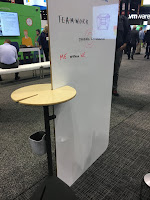With this post, I want to highlight some of the technologies in the exhibit hall that caught my eye, even if only for a brief moment. I am not endorsing them; I am simply pointing out that they had some features that struck me as useful.
1 Beyond: https://1beyond.com/automate is a set of cameras that allow for a wide scope shot with one camera while tracking the speaker with a second camera. Facial recognition software allows for intelligent tracking.
GlyphEd for data visualization: https://www.glyphed.com/ This looked rather strange, and maybe that was the appealing part of it, but its visualization made it easy for someone like me to spot the anomaly, Of course, it may have also just been a very clear example for the sales pitch.
 Steelcase may have done it again, creating a new collection, Flex collection - the wheel barrow approach strikes me as quite useful for maker spaces that need to be more flexible, and I was quite taken by their mobile whiteboard solution.
Steelcase may have done it again, creating a new collection, Flex collection - the wheel barrow approach strikes me as quite useful for maker spaces that need to be more flexible, and I was quite taken by their mobile whiteboard solution.Techready.io: https://techready.io/ - a potential solution for ensuring that devices used by online students are ready for online courses, online exams, and online participation. This may be too intrusive, but could help with better information when students need technical help and don't know enough about the devices they are using.
Pronto - different messaging platform in Canvas: https://trypronto.com/ - not sure that it is a real improvement, but it was touted as working better on mobile devices.
Acadly - for attendance and student response systems - https://www.acadly.com/ - this system could make it easier and more reliable to take attendance in any size class. The system also makes it easier to track attendance of individual students, identifying students at risk, and it incorporates some polling, quizzes, Q&A and other features for student engagement.
Nearpod - student response system on steroids - nearpod.com - I watched a bit more of a demo for this one, and it has some intriguing features: a large library of 360 degree, high resolution photos of, for example, a hospital room, that students can explore on their own devices, 3D models that an be rotated and zoomed into; universal design for learning features making it easy to have text or audio available to students, and some other interesting student engagement features. As the instructor, you can also choose if you want to run the presentation synchronously or have it set for student-paced, which makes this easier to use for a complete online course.
No comments:
Post a Comment